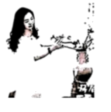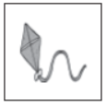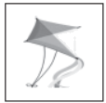| A. help B. at C. steps D. and E. by F. popular |
Creating paintings with different kinds of grain is known as grain painting (粮画). It has made a small village in Hebei Province
Shoudong Village in Hebei Province developed 11 grain painting companies
According to the records, local people have been creating paintings with grain since the Tang Dynasty (618-907). They use different kinds of grain and seeds as materials in different
Many local people make more money
2 . 
Do you know traditional Chinese flower arrangement? Do you know Zhang Yan? Zhang Yan is an inheritor (传承人) of traditional Chinese flower arrangement. She first met traditional Chinese flower arrangement in college from an optional course (选修课程) she took. Back then, she never imagined that a single course could be the starting point of her life-long career.
The art of traditional Chinese flower arrangement has been handed down since 1046 BC. Historical records show it has served as offerings at temples, decorations in the palace and art at homes. “Though flower arrangement has a history of more than 3,000 years, the flower arrangement is still limited to the bouquets (花束) in flower shops,” Zhang said. To break that stereotype (刻板印象), traditional Chinese flower arrangement was included in the second batch of National Intangible Cultural Heritage (非物质文化遗产). It is the art form’s rich historical connotation (内涵), and this national recognition (赏识) would lead to more public awareness.
Traditional Chinese flower arrangement is not only a decoration, but can also serve as a form of therapy (治疗) for modern busy people.“Unlike its Western counterpart, Chinese traditional flower management highlights simplicity.” Zhang said. The arranger must decide on what is truly necessary in his or her work and remove the rest. Sometimes learners are moved to tears because they begin to reflect on what is truly necessary in their lives.
“It came from traditional Chinese culture, and it is part of it,” Zhang argued. “Only when it absorbs lots of nutrition (营养) from traditional Chinese culture can it bloom and be world-known. Our aim is to develop and inherit traditional Chinese culture.”
1. What is people’s impression of flower arrangement?2. Ask ONE question about one of the following numbers from the passage.
A. 1046 B. 2008
3. What made the traditional flower arrangement our national heritage?
4. What can traditional Chinese flower arrangement be used for?
5. Which sentence in the passage has the similar meaning to the following one?
Sometimes people who learn to arrange flowers are moved to tears because they start to think about what they really need in life.
6. What can we do to make this art world-known?
3 . Tangchang, a town in Chengdu, is well-known for cloth shoes. With over 20 types, Tangchang cloth shoes are strong, comfortable, breathable and friendly to the environment. In 2018, they were added to Sichuan’s intangible cultural heritage list (非物质文化遗产名录).

63-year-old Lai Shufang has spent over 40 years making Tangchang cloth shoes. As a master, she says there are 32 steps to make a pair, but the most important step is making the soles. Layers (层) of white cloth are glued together with flour paste (糨糊). “To make good paste, we make it at a temperature of 85℃. If it’s too low or too high, the paste will not work,” Lai said. Then the pasted layers are dried and cut into different shapes. After this, the layered cloth is beaten again and again until it is tight enough to make soles and upper parts. The next step is to shape the two parts and glue them together. But still the soles’ edges (边缘) look fluffy. Through repeated polishing and trimming, the fluffy edges will become smooth. Then the cloth shoes are ready.
Lai’s hard work touched her son Ai Peng. In 2015, Ai decided to leave his job. He used Shu embroidery to make the shoes look more beautiful and opened a cloth shoe store online. He also set up shop windows to show the steps of making shoes, helping more people learn about the art of cloth shoes.
1. What’s the most important step in making Tangchang cloth shoes?| A.Making the soles. |
| B.Making the upper parts. |
| C.Making good flour paste. |
①Beating the layered cloth.
②Making flour paste at an exact temperature.
③Gluing the upper parts and the soles together.
| A.③②① | B.②③① | C.②①③ |
| A.Two. | B.Three. | C.Four. |
| A.The processes of making the cloth shoes. |
| B.The time Ms. Lai became a master of cloth shoes. |
| C.The most important material in making cloth shoes. |
4 . Chinese paper-cutting is one of the most popular art forms in the world.
In the beginning, Chinese people used thin materials like leaves to make the cutting. After paper was invented, they found that this material was easy to cut.
People make paper-cutting to show beautiful things and their good wishes.
| A.It has a long history. |
| B.It is easy to learn how to make paper-cutting. |
| C.And then paper became the main material for paper-cutting. |
| D.Chinese paper cutting has become more than just a traditional art form. |
| E.They also show traditional culture or their own feelings with different styles of paper-cutting. |
5 . Chinese knitting (结绳编织) is a great art form through which people send good luck and express best wishes. It shows the beauty of Chinese culture and the wisdom of Chinese people, and it enjoys popularity among international friends.
The art of knitting in China dates back to ancient times. Ancient people used the “rope knot tying” method to record information before the creation of the Chinese characters. Over time, it became a form of handicraft (手工艺) and developed greatly during the Ming and Qing Dynasties.
It continues to develop till today. Workers can skillfully make materials such as silk, cotton or wool which become daily goods and handicrafts, appearing in many forms like buttons, earrings and more.
Wang Xiaolan is an inheritor (传承人) of this Intangible Cultural Heritage (非物质文化遗产) from Chongqing. She has received great training in the art of knitting and has also brought changes to this traditional handicraft. She successfully uses knotting, weaving, drawing and other techniques to make products.
In 2019, Wang started a knitting workshop “Lanyuxuan”. To add a local flavor (特色) to this traditional art, her team has come up with new ideas for knitting pieces with symbols, such as ginkgo (银杏) leaves and bamboo. The team has won many prizes in competitions and the products are loved at home and abroad.
So far, Wang’s workshop has trained over 100 people who want to learn it for free. They try their best to impart knitting skills and knowledge to the next generation. In the future, they will join in different exhibitions, competitions, and take every chance to spread knitting culture, show knitting skills, and share great Chinese stories.
1. According to the passage, people ________ through Chinese knitting.| A.are thirsty for peace and safety | B.are thirsty for success and wealth |
| C.send messages and show directions | D.send good luck and express best wishes |
| A.Recording information. | B.Making some money. |
| C.Creating Chinese characters. | D.Sharing Chinese stories. |
①She has invented new materials for knitting.
②She has combined many different techniques.
③She has taken part in competitions and won many prizes.
④She and other teammates have come up with new ideas of products.
| A.①②③ | B.①②④ | C.①③④ | D.②③④ |
| A.pass by | B.put off | C.pass on | D.put down |
| A.Handicrafts—A Special Part of Traditional Culture |
| B.Chinese Knitting—An Intangible Cultural Heritage |
| C.Wang Xiaolan—An Inheritor of Chinese Knitting |
| D.Chinese Characters—An Important Cultural Invention |
6 . You must have heard of the term (词语) neo-Chinese style, but do you know what exactly it is? It is a trendy fashion that combines traditional Chinese culture with modern designs.
Neo-Chinese style has become popular among young people who like to include traditional Chinese elements into their daily wear. This new style of clothing replaces the formal and serious look of traditional hanfu with a simpler and more comfortable feel.
In the neo-Chinese style, designers use traditional ornaments (装饰) like Chinese frog buttons and wrap fronts in everyday clothing, These elements give the clothes a modern yet traditional look that many people find appealing (吸引人的).
The trend of neo-Chinese style is also influencing the fabrics used in clothing. For example most of the materials used in the neo-Chinese clothes are cotton, linen (麻) and silk. In addition, this year’s clothing for men has more Chinese stand-up collars and patterns like rivers and clouds, while women prefer bright colors.
So, what we see is that this new fashion trend is loved by the younger generation, who wants to express their individuality (个性). The style also allows them to express their cultural confidence and cultural identity. They are drawn to the beauty of traditional Chinese culture, making this style a hit. As a result, the neo-Chinese style reflects the aesthetic (审美) preferences of the young generation, which is both fashionable and meaningful.
1. How does the writer start the passage?| A.By explaining a term. | B.By showing some facts. | C.By listing some numbers. |
| A.It’s soft fabric. | B.It’s simple and convenient feel. | C.Its modern yet traditional look. |
| A.图案 | B.布料 | C.款式 |
| A.Why neo-Chinese style is popular among the young. |
| B.How young people express their individuality. |
| C.Where the beauty of traditional Chinese culture lies. |
7 . Weifang, Shandong has a long history of making kites. It dated back to 2,000 years ago. At first, kites were used by the army for measuring the distance and communication. During the Ming Dynasty, kites became popular among people for fun.
Weifang kites are made from bamboo and decorated with traditional Chinese paintings. Weifang kite-making was included in the national-level intangible cultural heritage list in 2006. The International Kite Festival has been held in Weifang each year since 1984.
Yang Hongwei, 58, is an inheritor of the Weifang kite-making technique. Yang often saw kites with bright colors and different patterns in her grandfather’s workshop when she was little. Yang learned the technique from her grandfather when she was 16. After practicing the technique for 10 years, she started her own shop in 1992. “Every time I see these beautiful kites, my boredom and bad feelings go away,” said Yang.
On Yang’s kites, people can see not only common patterns like butterflies and swallows, but also some prints telling Chinese myths, legends and history. For example, she once made a kite showing a phoenix (凤凰) that was lined with pictures of 50 famous women from Chinese history on each side. Each woman is different in looks, clothes and makeup style. It took Yang a lot of time to check historical records and talking about details with professionals.
In her free time, she travels to different countries to tell people stories of Chinese kites and the traditional ways they are made. “It is an important job of mine, to spread our heritage around the world and pass it on to the next generation,” she said.
1. Which section of a magazine does this passage come from?| A.Health. | B.Culture. | C.Sports. | D.Transportation. |
A. | B. | C. | D. |
| A.Abilities. | B.Prices. | C.Colors. | D.Shapes. |
| A.myths | B.legends | C.politics | D.history |
| A.Home of Kites | B.Uplifting Tradition of China |
| C.History of Kites | D.Story of Yang Hongwei |
8 . Recently, students went to Yuxian County in Hebei to learn about a special kind of Chinese art called “Yuxian County paper-cutting”. It
When they entered the studio of Zhou Shuying, the inheritor (传承人), they were amazed by the artwork
According to Zhou, Yuxian County paper-cutting is different from
Through this learning experience, the students truly felt the
| A.recognizes | B.recognized | C.is recognized |
| A.with | B.on | C.in |
| A.alive | B.lively | C.living |
| A.others | B.other | C.another |
| A.the | B.a | C.an |
| A.is | B.was | C.has been |
| A.Shown | B.Showing | C.To show |
| A.Final | B.Finals | C.Finally |
| A.beauty | B.beautiful | C.beautifully |
| A.What | B.How | C.How a |
Have you ever heard of bamboo weaving (竹编技艺)? A piece of bamboo art caught people’s attention at the
Born in Wuzhen, Zhejiang Province, the 38-year-old man has
These experiences pushed
Qian has taught the bamboo weaving course at his old school. The course
His dream is to see more people enjoy and understand the beauty of bamboo weaving. He believes that this traditional art has the power to bring happiness to people’s lives.

As the days of summer fall upon China, modern people prefer to choose light and thin clothing.
Ancient stories vividly describe the lightweight clothing worn during summer. One tale tells that in the Tang Dynasty a foreign trader
If it is hard to imagine the clothing, here are some
Well-suited for the southern areas of China, luo has large holes in the material, making it lightweight and breathable. From the Han Dynasty to the Tang and Song Dynasties, luo was mainly
For a long time, bamboo products, like mats and pillows, were seen
Although the living standards



